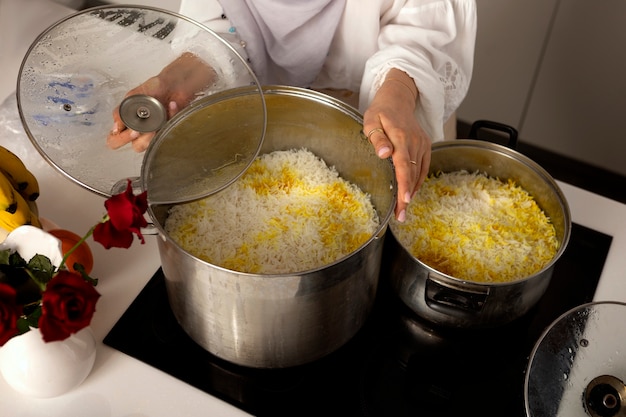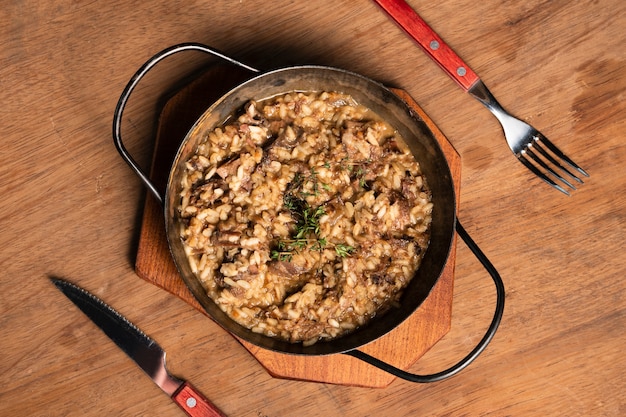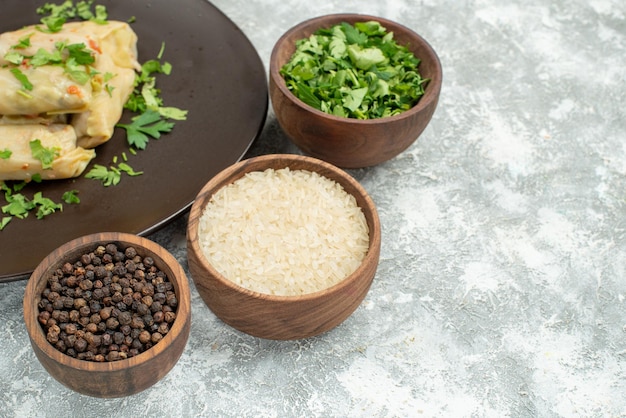Let's face it, cooking brown rice can sometimes feel like a culinary gamble. One minute you're diligently following instructions, the next you're staring at a pot of mushy, overcooked rice or dry, crunchy grains. I've been there, and after years of experimenting (and a few burnt pots, let's be honest), I've finally cracked the code for consistently perfect brown rice every time.
In this article, I'll be sharing my tried and tested method for cooking brown rice on the stovetop, a technique I've perfected over time. Get ready to bid farewell to mushy rice and say hello to fluffy, perfectly cooked grains. Let’s get started!
(Part 1) The Essential Equipment: Your Rice-Cooking Arsenal

Before we dive into the recipe, let's talk about the equipment. You'd be surprised how much a few key tools can make a difference in the texture of your rice. The good news is, you probably already have most of these in your kitchen.
A Large Pot with a Lid: The Foundation of Your Rice Journey
A good, sturdy pot is essential for cooking rice. Look for a pot with a tight-fitting lid to ensure even heating and prevent moisture from escaping. I prefer a pot with a thick base, as this helps prevent scorching and uneven cooking. Think of it as a fortress for your rice, keeping it safe and warm while it cooks.
Measuring Cups and Spoons: Precision is Key
Precision is key when it comes to cooking rice, so using accurate measuring tools is important. I find that using a measuring cup specifically designed for rice is helpful, as it often has a "rice" line that helps you get the right amount. It's like having a little guide for perfect rice proportions.
A Fine-Mesh Sieve or Strainer: Rinsing Away the Starch
A sieve or strainer is essential for rinsing the rice before cooking. This helps remove any excess starch, which can make your rice sticky. Think of it as a spa treatment for your rice, giving it a fresh start.
A Wooden Spoon or Spatula: Stirring for Even Cooking
A wooden spoon or spatula is handy for stirring the rice during cooking and ensuring even heating. It's like a conductor leading the rice to a perfect symphony of textures.
A Fork or Rice Paddle: Fluffing Up the Grains
Once the rice is cooked, use a fork or rice paddle to fluff the grains and separate them. This helps prevent them from sticking together. Think of it as a gentle massage for your rice, giving it a fluffy, airy finish.
(Part 2) The Rice: Choosing the Right Kind

There's a whole world of rice varieties out there, and each one has its own unique texture, flavor, and cooking time. For this recipe, I recommend using long-grain brown rice. long-grain rice has a firm texture and holds its shape well, making it ideal for stir-fries, salads, and other dishes where you want the rice to be distinct. I've tried a few different brands, but I always find myself coming back to Uncle Ben's. Their rice consistently cooks well and has a pleasant flavour.
Brown Rice: A nutritional powerhouse
Speaking of brown rice, let's not forget its nutritional benefits. Brown rice is a whole grain, meaning it contains the bran and germ, which are packed with fiber, vitamins, and minerals. It's a good source of manganese, magnesium, and selenium, and it's also a low-glycemic index food, meaning it doesn't cause a rapid spike in blood sugar levels. It's basically a little powerhouse of goodness.
Some people might think brown rice is more difficult to cook than white rice, but I disagree. The texture is more appealing, and I find it takes less time to cook once you get the hang of it.
(Part 3) Rinse, Rinse, Rinse! The Importance of a Good Wash

Before you start cooking, it’s important to rinse your rice. This step is crucial because it removes any excess starch. This starch can make the rice sticky and mushy during cooking. To rinse your rice, simply place it in a fine-mesh sieve or strainer and run cold water over it until the water runs clear. I usually rinse my rice for a few minutes to ensure that it’s thoroughly cleaned. You’ll be surprised how much extra starch comes out!
(Part 4) The Magic Ratio: Rice to Water
One of the most common mistakes people make when cooking rice is using the wrong ratio of rice to water. I've definitely been there! But fear not, the secret to perfect brown rice is the magic ratio: 1 cup of rice to 1 3/4 cups of water. This ratio ensures that the rice absorbs just the right amount of water, resulting in fluffy, perfectly cooked grains.
(Part 5) The Cooking Process: A Step-by-Step Guide
Now, for the exciting part – the cooking! I've broken it down into simple steps so that anyone can achieve perfect brown rice:
- Rinse the Rice: As we discussed, start by rinsing the rice thoroughly. You can do this by placing the rice in a fine-mesh sieve or strainer and running cold water over it until the water runs clear. It's a quick and simple step that makes a big difference!
- Combine Rice and Water: Add the rinsed rice to a large pot with a lid. Add the water, ensuring the ratio is 1 cup of rice to 1 3/4 cups of water. If you're using more or less rice, adjust the water accordingly. For example, if you are cooking 2 cups of rice, you will need 3.5 cups of water. This is the moment where the magic of the ratio comes into play.
- Bring to a Boil: Place the pot over medium-high heat and bring the rice and water to a boil. You’ll see tiny bubbles appearing on the surface. Don’t be tempted to stir at this stage; this will just cause the rice to become sticky. Just let it do its thing!
- Reduce Heat and Simmer: Once the water starts boiling, reduce the heat to a low simmer and cover the pot with a tight-fitting lid. Now comes the waiting game. Simmer the rice for about 40 minutes, or until the water has been absorbed and the rice is tender. This is the part where patience is key.
- Let it Rest: After 40 minutes, turn off the heat and let the rice sit undisturbed for 10-15 minutes. This step is crucial because it allows the rice to absorb any remaining moisture and become fluffy. This is the final step in the rice's transformation.
- Fluff and Serve: After the resting period, carefully fluff the rice with a fork or rice paddle. This separates the grains and prevents them from sticking together. Your perfectly cooked brown rice is now ready to serve! This is the moment of culinary triumph!
(Part 6) Tips and Tricks for Perfect Rice
Over the years, I’ve learned a few tricks that help me cook the most delicious brown rice every time. Here are some tips that might be useful:
- Don't Overcook: The key to perfect rice is not overcooking it. If you find that the rice is still too hard after 40 minutes, add a little more water, cover the pot, and simmer for a few more minutes. But be careful not to overdo it! Overcooked rice can become mushy, so it's important to keep a close eye on it.
- Salt it Right: A little salt can enhance the flavour of your rice. Add a pinch of salt to the water when you start cooking. The amount of salt will depend on your preference, but I usually add about 1/4 teaspoon for a cup of rice. A little salt goes a long way!
- Use Cold Water: Cold water ensures that the rice cooks evenly. I always use cold water when cooking rice and I find it makes a real difference. Cold water allows the rice to cook evenly, avoiding any hot spots.
- Keep an Eye on the Pot: It’s always a good idea to keep an eye on the rice while it’s simmering. Check it regularly to ensure that the water is being absorbed properly. If the water is being absorbed too quickly, reduce the heat a little. If it’s not absorbing quickly enough, increase the heat slightly. Monitoring the rice is key to a successful outcome.
(Part 7) Experiment with Flavour: Beyond Basic Brown Rice
Once you’ve mastered the basic technique, you can start experimenting with different flavour combinations. Here are some ideas to get you started:
Garlic and Herbs: A Classic Combination
Add a clove of garlic to the pot along with the water for a subtle, flavourful aroma. You can also experiment with different herbs, such as rosemary, thyme, or basil. For example, add a sprig of rosemary to the pot for a herby flavour. The possibilities are endless!
Citrus Twist: A Refreshing Change
For a refreshing twist, add a squeeze of lemon or lime juice to the rice while it’s cooking. The citrus flavour complements the rice beautifully. You can also add a thin slice of lemon or lime to the pot for an extra burst of flavour. A touch of citrus brightens up the rice and adds a nice acidity.
Spiced Rice: A World of Flavour
Get creative with spices! Add a pinch of cumin, coriander, or turmeric to the water for a warm, earthy flavour. Experiment with different spice combinations to create your own unique flavour profiles. Spices can take your rice from simple to extraordinary.
(Part 8) Leftovers: Storing and Reheating
We all know the feeling of having a bit of leftover rice. Don’t throw it away! Leftover brown rice can be used in countless ways. Here’s how to store and reheat it:
Storing Leftover Rice: Keeping it Fresh
Allow the rice to cool completely before storing it in an airtight container in the refrigerator. Leftover rice will keep well for up to 3-4 days. This way, you can enjoy it later without it going bad.
Reheating Rice: Bringing Back the Flavour
There are a few ways to reheat rice. You can reheat it in the microwave, on the stovetop, or even in the oven.
- Microwave: Place the rice in a microwave-safe dish and heat on high for 1-2 minutes, or until warmed through. You might need to stir it halfway through to ensure even heating. This is a quick and easy option for reheating rice.
- Stovetop: Add the rice to a saucepan and add a little water or broth. Heat over medium heat, stirring occasionally, until the rice is heated through. This method allows you to add extra moisture to the rice.
- Oven: Preheat the oven to 350 degrees fahrenheit. Place the rice in a baking dish and cover it with foil. Bake for 15-20 minutes, or until warmed through. This method is ideal for reheating larger quantities of rice.
(Part 9) Beyond the Basics: Variations and Ideas
Now that you’ve mastered the basics, let’s explore some variations and ideas to elevate your brown rice game.
brown rice salad: A Refreshing and Nutritious Meal
Brown rice makes a fantastic base for salads. Try combining it with chopped vegetables, herbs, nuts, and a flavorful dressing. Here’s a simple recipe for a brown rice salad:
- 1 cup cooked brown rice
- 1/2 cup chopped cucumber
- 1/4 cup chopped red onion
- 1/4 cup chopped fresh cilantro
- 1/4 cup chopped roasted peanuts
- Dressing: 2 tablespoons lime juice, 1 tablespoon olive oil, 1 teaspoon honey, a pinch of salt and pepper
Combine all the ingredients in a bowl and toss gently to coat. Let it chill for at least 30 minutes before serving. You can also add other vegetables like cherry tomatoes, bell peppers, and avocado to your salad. This salad is a great option for a light and healthy lunch or dinner.
Brown rice pudding: A Creamy and Comforting Dessert
Brown rice can be used to create creamy, comforting pudding. This recipe calls for coconut milk, which adds a subtle sweetness and richness.
- 1 cup cooked brown rice
- 1 can (14 ounces) full-fat coconut milk
- 1/4 cup sugar
- 1/4 teaspoon ground cinnamon
- 1/4 teaspoon vanilla extract
Combine all the ingredients in a saucepan and heat over medium heat, stirring constantly, until the sugar is dissolved and the pudding is heated through. Serve warm and enjoy! This pudding is a comforting and satisfying dessert.
Brown Rice Risotto: A Heartier Version of a Classic
Risotto is traditionally made with arborio rice, but you can also use brown rice for a heartier and more nutritious version. This recipe calls for vegetables and Parmesan cheese.
- 1 cup cooked brown rice
- 1 tablespoon olive oil
- 1/2 cup chopped onion
- 1/2 cup chopped carrots
- 1/2 cup chopped celery
- 2 cups vegetable broth
- 1/4 cup grated Parmesan cheese
- Salt and pepper to taste
Heat the olive oil in a large saucepan over medium heat. Add the onion, carrots, and celery and cook until softened, about 5 minutes. Add the brown rice and cook for 1 minute. Gradually add the vegetable broth, 1 cup at a time, stirring constantly until each cup is absorbed before adding the next. Cook for 20-25 minutes, or until the rice is creamy and the broth is absorbed. Stir in the Parmesan cheese and season with salt and pepper to taste. This risotto is a hearty and flavorful main course.
brown rice pancakes: A Delicious Way to Use Leftovers
You can even use brown rice to make pancakes! This recipe is surprisingly delicious and a great way to use up leftover brown rice.
- 1 cup cooked brown rice
- 1 egg
- 1/2 cup milk
- 1 tablespoon melted butter
- 1/2 teaspoon baking powder
- 1/4 teaspoon salt
Combine all the ingredients in a blender and blend until smooth. Heat a lightly oiled griddle or skillet over medium heat. Pour 1/4 cup of batter onto the hot griddle for each pancake. Cook for 2-3 minutes per side, or until golden brown and cooked through. Serve with your favorite toppings, such as fruit, syrup, or nut butter. These pancakes are a delicious and nutritious way to start your day.
(Part 10) FAQs: Answering Your Rice-Related Questions
Now that you've learned my method for cooking perfect brown rice, here are some frequently asked questions that might help answer any remaining questions:
1. Can I use any type of brown rice?
While I recommend using long-grain brown rice for this recipe, you can experiment with other types of brown rice, such as short-grain or medium-grain. However, the cooking time may vary. If you're using a different type of rice, I suggest checking the package for recommended cooking instructions. Each type of rice has its own unique cooking characteristics.
2. What if my rice is still hard after 40 minutes?
If your rice is still hard after 40 minutes, it may not have absorbed enough water. Add a little more water, cover the pot, and simmer for a few more minutes. Check the rice every few minutes until it is tender. It's better to err on the side of caution and add a little water at a time.
3. Can I cook brown rice in the oven?
Yes, you can cook brown rice in the oven. Preheat the oven to 350 degrees Fahrenheit. Combine 1 cup of rinsed rice with 1 3/4 cups of water in a baking dish. Cover the dish tightly with foil and bake for 45-60 minutes, or until the rice is tender and the water is absorbed. This is a great option for a hands-off cooking method.
4. What can I do with leftover brown rice?
Leftover brown rice is incredibly versatile! You can use it in salads, stir-fries, soups, or even as a base for rice pudding. I love to add leftover brown rice to my breakfast bowl with fruit, nuts, and yogurt. The possibilities are endless!
5. How can I make brown rice more flavorful?
There are many ways to enhance the flavor of your brown rice. You can add aromatics like garlic, herbs, or spices to the pot while cooking. You can also mix in different flavors after the rice has cooked, such as lemon zest, toasted nuts, or dried fruit. Experiment and have fun with it! Get creative and add your own personal touch to your rice.
I hope this guide has helped you learn how to cook perfect brown rice on the stovetop. Remember, it takes a little practice, but once you master it, you'll be able to enjoy fluffy, delicious brown rice anytime!
Everyone is watching

Prime Rib Roast Cooking Time Chart: Per Pound Guide
Cooking TipsPrime rib roast. Just the name conjures images of lavish dinners, crackling fires, and hearty laughter. It’s ...

How Long to Bake Potatoes in the Oven (Perfect Every Time)
Cooking TipsBaked potatoes are a staple in my kitchen. They're incredibly versatile, delicious, and surprisingly easy to m...

Perfect Rice Every Time: The Ultimate Guide to Cooking Rice
Cooking TipsAs a self-proclaimed foodie, I've always been a bit obsessed with rice. It's the foundation of countless cuisi...

The Ultimate Guide to Cooking Asparagus: Tips, Techniques, and Recipes
Cooking TipsAsparagus. The mere mention of this spring delicacy conjures up images of vibrant green spears, crisp and burs...

Ultimate Guide to Cooking the Perfect Thanksgiving Turkey
Cooking TipsThanksgiving. Just the word conjures up images of overflowing tables laden with delicious food, the scent of r...
